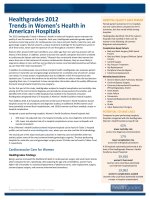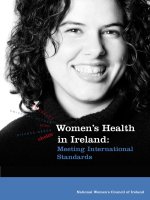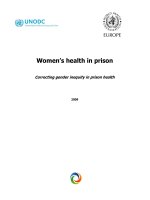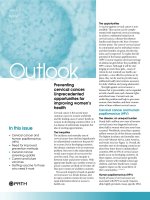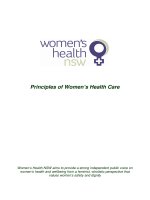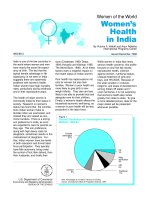Women’s Health in Tanzania docx
Bạn đang xem bản rút gọn của tài liệu. Xem và tải ngay bản đầy đủ của tài liệu tại đây (3.55 MB, 24 trang )
Women’s Health
in Tanzania
Key Findings from the 2004-05
Tanzania Demographic and Health
Survey and the 2003-04 Tanzania
HIV/AIDS Indicator Surveyii
Contents
Introduction iii
About the Surveys 1
Women’s Status 2
Marriage 5
Fertility and Family Planning 6
Nutrition 7
Pregnancy 8
Female Genital Cutting 10
Sexual Behaviour 11
HIV/AIDS 12
Conclusions and Recommendations 14
Note to the Reader 17
Tanzania Gender Prole 18
Photo courtesy of Concern
iii
Introduction
What position do Tanzanian women hold in society? Do they have the same access to education as men? Can
they make important decisions about their health care or about the money they earn? Do they have any say in
their husbands’ behaviour? e answers to these and other important questions can be found in the results of
two recent surveys, the 2004-05 Tanzania Demographic and Health Survey and the 2003-04 Tanzania HIV/
AIDS Indicator Survey.
ese surveys provide valuable new information about the status and well-being of women in Tanzania.
Unfortunately, the picture that emerges is not very positive. Women in Tanzania have worse health and fewer
educational and economic opportunities than men. ey are more likely to have HIV/AIDS, less likely to pursue
higher education, less likely to access the media, and they have fewer decision-making powers. Pregnancy and
childbearing continue to take a great toll on women in this country. And while poverty aects all Tanzanians,
Tanzanian women have higher rates of poverty than do Tanzanian men.
is key ndings report summarizes the major survey ndings about women’s education, status, fertility, health,
and other signicant measures of their empowerment. Clearly, there is much work to be done to help women in
Tanzania, especially the poorest women. anks to these surveys, policy makers, community leaders, religious
leaders, and educators now have better information to cra services and policies that will li up women and
improve their collective well-being. e time to empower Tanzanian women is now. To learn more, read on.
1
About the Surveys
is key ndings report presents an overall picture of women’s health
and well-being in Tanzania. e report is based on ndings from the
2004-05 Tanzania Demographic and Health Survey (TDHS) and the
2003-04 Tanzania HIV/AIDS Indicator Survey (THIS).
2004-05 Tanzania Demographic and Health Survey
e 2004-05 Tanzania Demographic and Health Survey is the most
recent in a series of national surveys conducted in Tanzania to meas-
-
ure levels, patterns, and trends in fertility, family planning, and health
indicators. e previous surveys were carried out in 1991-92, 1994,
1996, and 1999. e 2004-05 TDHS was conducted by the National
Bureau of Statistics (NBS).
e 2004-05 survey included a nationally representative sample of
10,329 women and 2,635 men from approximately 9,700 households.
is sample provides estimates for Tanzania as a whole (including
Zanzibar), for urban and rural areas, and, for most indicators, an esti-
-
mate for each of the 26 administrative regions.
2003-04 Tanzania HIV/AIDS Indicator Survey
e 2003-04 Tanzania HIV/AIDS Indicator Survey (THIS) is the rst nationally representative, population-
based survey in Tanzania to include HIV testing. e THIS obtained national baseline data on the prevalence
of HIV infection. In addition to measuring HIV prevalence among women and men age 15-49, the survey
obtained information on knowledge, attitudes, and behaviour regarding HIV/AIDS, orphans and vulnerable
children, and other indicators such as fam-
-
ily planning.
e THIS included a nationally representa-
-
tive sample of 6,863 women and 5,659 men
from about 6,500 households from across
Tanzania mainland. e THIS was conducted
by the Tanzania Commission for AIDS
(TACAIDS) and the NBS. Zanzibar was
not included in the THIS.
Use of survey data in this
report
is document refers to data from both of
these surveys. Unless noted, however, the data
discussed comes from the 2004-05 TDHS.
Photo courtesy of R. Selgado
Kigoma
Mwanza
Manyara
Singida
Mbeya
Pwani
Shinyanga
Tabora
Mara
Kagera
Arusha
Kilimanjaro
Tanga
Dodoma
Rukwa
Iringa
Moro-
goro
Lindi
Ruvuma
Mtwara
Dar es Salaam 8
%
Pemba Kasikazi
n
Pemba Kusini 2
Unguja Kasikazini
3
Unguja Kusini 12%
Town Magharibi 1
0
Tanzania
2
Women’s Status
What position do women hold in Tanzanian society? Overall, the picture is mixed, at best. e results from
the TDHS and THIS highlight several areas of inequality between men and women, such as education and
decision-making. e results also point to key areas where women could be given more power to control and
improve their lives. Fortunately, there is some evidence that younger generations are experiencing more op-
portunities than their mothers and grandmothers did.
Education
Education is one of the most important ways to empower women – to give them the skills, knowledge, and con-
dence they need to take care of themselves and
their families. roughout Tanzania, wom-
en are less educated than men. Although
most Tanzanians have some education,
one out of three women (33 percent) has
never attended school, compared with one
out of four men (25 percent).
Men and women living in cities are
more likely to have some education
than rural residents. Women’s levels
of education, however, dier signi-
cantly among the regions. For exam-
ple, between one third to one half of the
women in Tabora, Dodoma, Mbeya, Rukwa,
Shinyanga, Manyara, Zanzibar North, and
Pemba North have never attended school. Rural women
have the least access to education. Over 30 percent of them have
never been to school, compared with 15 percent of rural men.
Fortunately, this educational imbalance is changing with the younger generations. More girls are now at-
tending school. Nationwide, 75 percent of girls and 71 percent of boys age 7 to 13 attend primary school.
Among children age 7 to 19, girls and boys are equally likely to attend primary or secondary school. Children
living in urban areas, both girls and boys, are much more likely to attend school than children in rural areas.
Unfortunately, most young Tanzanians still do not attend secondary school. Only 7 percent of youth continue
their education beyond primary school. Among the poorest households, boys are twice as likely to attend sec-
ondary school as girls.
Kigoma
25%
Mwanza
23%
Manyara 32%
Singida
28%
Mbeya
31%
Pwani
25%
Shinyanga 32%
Tabora
44%
Mara
17%
Kagera
27%
Arusha
19%
Kilimanjaro
4%
Tanga
24%
Dar es Salaam 8%
Dodoma
30%
Rukwa
45%
Iringa
18%
Moro-
goro
25%
Lindi
25%
Ruvuma
12%
Mtwara
29%
Pemba N. 40%
Pemba S. 24%
Zanzibar N. 34%
Zanzibar S. 12%
Town West 10%
Percent distribution of women
age 15-49 with no education
Rural women have the least access to education. Almost 40 percent of
them have never been to school, compared with 29 percent of rural men.
3
Access to health care
Over 60 percent of all women feel they face big
barriers to accessing health care when they are
sick. e most common problems are: getting
money for treatment (40 percent); the distance
to the health facility (38 percent); having to take
transportation (37 percent); and not wanting
to go alone (24 percent). Problems in accessing
health care are felt most acutely by women with
little or no education and women from poorer
households.
Access to media
Television, radio, and newspapers can be impor
tant sources of information for women and men.
Overall in Tanzania, there has been a
signicant increase in mass media ex-
-
posure over the last ve years. Women’s
experience with media, however, still lags
behind men’s in both urban and rural
areas. One-third (33 percent) of women
have no access to any media, compared
to 17 percent of men. Radio is the
most common form of media in
Tanzania: 62 percent of women
and 80 percent of men listen to the
radio at least once a week.
Poor and rural women are least likely
to be exposed to media. Among the
poorest households in the country, 71
percent of women have no access to radio,
newspapers, or television, compared with 38 per-
-
cent of the poorest men.
Kigoma
41%
Mwanza
28%
Manyara 40%
Singida
67%
Mbeya
40%
Pwani
33%
Shinyanga 37%
Tabora
47%
Mara
32%
Kagera
43%
Arusha
20%
Kilimanjaro
23%
Tanga
25%
Dar es Salaam 9%
Dodoma
53%
Rukwa
53%
Iringa
29%
Moro-
goro
32%
Lindi
26%
Ruvuma
28%
Mtwara
41%
Pemba N. 31%
Pemba S. 18%
Zanzibar N. 12%
Zanzibar S. 5%
Town West 4%
Percentage of women who have no access to any media
Problems Accessing Health Care
Having to take transport
Percent of women who cite the above
problems in accessing health care
Not wanting to go alone
24
37
Getting money
for treatment
Distance to health facility
40
38
Knowing where to
go for treatment
Getting permission to
go for treatment
6
6
Unfriendly provider
Concern that there may not
be a female provider
14
8
Photo courtesy of Unicef
3
4
Photo courtesy of Concern
Employment
Employment can be an important way to empower
women, especially when women can control their
own money and resources. Women are more likely
than men to have physically demanding work, which
can have negative eects on their health. e vast
majority of women (78 percent) work in agriculture.
e next most common line of work for women is
unskilled manual labour. Even the wealthiest wom-
-
en are more likely to work in unskilled manual la-
-
bour (32 percent) and agriculture (23 percent) than
in other occupations.
Agriculture is also the most common occupation for
men (71 percent). Men, however, are far more like-
-
ly to work in professional and skilled jobs. Almost
20 percent of men work in professional, clerical,
sales, or skilled manual labour jobs, compared with
9 percent of women.
Household decision-making
A woman’s ability to make decisions about her life is one way to measure her degree of empowerment. e
TDHS asked women four questions about decision-making in their households: who has the nal say about
health care, large household purchases, visits to family and friends, and how many children to have and when?
Only a quarter (26 percent) of women participate in all of these decisions, and 21 percent do not take part in
any. Women’s power to make decisions varies with the type of decision. For example, most married women
(79 percent) decide what food to cook each day and make decisions about their own health care (59 percent).
But they have less say in decisions to visit family or friends. Only a third have a say in large purchases. e
amount of education a woman has does not appear to aect her participation in decision-making.
Men are far more likely than women to work in professional and skilled
jobs. Almost 20 percent of men work in professional, clerical, sales, or
skilled manual labor jobs, compared with 9 percent of women.
5
Refusal to have sex
e degree to which a woman can control when and
with whom she has sex has a direct eect on her
fertility and reproductive health. Most women (63
percent) and men (59 percent) agree that a woman
is justied in refusing sex with her husband if she:
knows her husband has a sexually transmitted in-
-
fection (STI); knows her husband had sex with an-
-
other woman; has recently given birth; or is tired
or not in the mood. Still, nearly 40 percent of men
and women do not believe these are valid reasons to
refuse sex. ese types of attitudes and behaviours
increase women’s risks of contracting STIs, includ-
-
ing HIV/AIDS, and having unwanted pregnancies.
Marriage
Most Tanzanian women age 15 to 49 are married or in a relationship. Overall, about 60 percent of women
and 50 percent of men are married. An additional 9 percent of women and 5 percent of men are in ‘informal’
unions. About a quarter of women (23 percent) have never been married. By contrast, 42 percent of men age
15 to 49 have never married. Ten percent of women are divorced, separated or widowed, which puts them at
greater risk for being poor. Nearly half (46 percent) of all widowed women are denied their inheritance and
dispossessed of their property.
Attitudes Towards Wife Beating
Neglects
the children
Percentage of women and men who believe
a husband is justified in hitting or beating
his wife for different reasons.
Refuses to have
sex with him
43
46
Burns the food
Argues with him
20
29
Percentage
who agree with
at least one reason
Goes out without
telling him
47
60
10
23
27
28
15
42
Women
Men
!GEATÚRSTMARRIAGE
Early marriage limits women’s access to education
and job training. Among women age 25 to 49, half
are married before age 19. Men, on the other hand,
wait until they are older before they marry, on av-
-
erage ve to six years later than women. Women
who marry at a young age tend to have their rst
child earlier and give birth to more children than
women who marry later.
Polygyny (multiple wives)
Polygyny describes a marriage in which a man
has more than one wife. In Tanzania, about one-
fourth of married women are in polygynous mar-
-
riages. Rural, less educated women and women of
middle to lower economic status are more likely
than other women to have one or more co-wives.
ere are clear regional dierences. Polygyny is
most common in Mara, Shinyanga, and Zanzibar
North.
Wife beating
Many Tanzanian men and women believe that wife
beating is acceptable under some circumstances.
Women are more inclined than men to sanction do-
-
mestic violence. Sixty percent of women and 42 per-
-
cent of men believe that wife beating is justied in
at least one of ve situations: 1) a wife burns food;
2) a wife argues with her husband; 3) a wife goes out
without telling her husband; 4) a wife neglects the
children; or 5) a wife refuses to have sex with her
husband.
ere are, however, large dierences among the re-
-
gions. For example, over 80 percent of women from
Kigoma, Mara, and Tabora agree with at least one
reason for wife beating compared with only 33 per-
-
cent of women in Kilimanjaro region.
Postnatal care
Postnatal care, that is, medical care within the rst two days aer delivery, helps prevent complications from
childbirth. In fact, most maternal and newborn deaths occur within 48 hours aer delivery. In Tanzania, only
13 percent of women who gave birth at home were examined by a trained health care professional within two
days of delivering. In addition, only 20 percent of women received vitamin A supplementation within two
months of childbirth. Vitamin A supplementation prevents night blindness in women and malnutrition among
their breastfed babies.
Teenage pregnancy
Many Tanzanian women are sexually active before marriage. Among women age 20-49, half started having sex
by the age of 17. One-fourth of women age 15-19 are pregnant or have already given birth. Adolescent mothers,
especially those under the age of 18, have been
shown to be more likely than older mothers to
suer from pregnancy and delivery complica-
-
tions, aecting the health of both the mother
and the child. Having a child during the teen-
-
age years can also limit women’s opportunities
for better education, jobs, and income.
Malaria and pregnancy
Malaria during pregnancy leads to multiple
problems for the mother and the baby - low
birth weight, infant mortality, maternal anae-
-
mia, spontaneous abortion, and stillbirth. Only
18 percent of all women and 16 percent of preg-
-
nant women sleep under insecticide-treated
mosquito nets (ITNs). Treated bed nets are far more available in cities than in rural areas. As a result, urban
households are three times more likely to own ITNs than rural households.
As a protective measure, it is recommended that all pregnant women in Tanzania receive intermittent preven-
-
tive treatment for malaria twice or more during the second and third trimester of pregnancy. More than half
(53 percent) of pregnant women report having taken at least one dose of the medicine. Only 22 percent, how-
-
ever, received the recommended two or more doses.
!DOLESCENT#HILDBEARINGBY%DUCATION
.O
EDUCATION
0RIMARY
INCOMPLETE
0RIMARY
COMPLETE
0ERCENTOF
WOMENAGE
WHO
AREEITHER
PREGNANTOR
ALREADY
MOTHERS
3ECONDARY
Photo courtesy of Concern
10
Female Genital Cutting
Female genital cutting (FGC) can cause serious health problems for girls and women, including complica
tions during childbirth and, occasionally, death from haemorrhage and infection. For these reasons, FGC,
also known as female circumcision or female genital mutilation, has been challenged in Tanzania. e 1998
Tanzanian Special Provision Act specically outlawed female circumcision throughout the country.
Prevalence of FGC
In most regions of the country, less than 3 percent
of women have undergone FGC. In a few regions,
however, more than 50 percent of women are cir-
-
cumcised, including Manyara (81 percent), Do-
-
doma (68 percent), and Arusha (55 percent).
In Tanzania, the overall prevalence of FGC is
15 percent, down slightly from 18 percent in
1999. In Singida region, however, the prac-
-
tice increased from 25 percent in 1996 to
43 percent in 2004-05. For the overwhelming
majority of circumcised women (91 percent),
circumcision involved cutting and removal of
esh. For 2 percent of women, the procedure
included sewing up the vaginal opening (inbu-
-
lation), which is the most radical and risky form of
FGC.
About half of circumcised women underwent the procedure during in-
-
fancy or young childhood. It is more common among poorer women and
slightly more common among Protestants than other religious groups.
Attitudes towards FGC
Most Tanzanians say they disapprove of FGC. Nine out of ten Tanzanian women and men who had heard
of FGC believe that the practice should be discontinued. Disapproval of FGC is greatest among women and
men in urban areas, and those with higher education and household wealth. Only a small minority of women
(5 percent) believe the practice should be continued. ese women are more likely to be circumcised them-
-
selves and to live in rural areas, including the Manyara and Arusha regions. Nearly 9 percent of men believe the
practice should be continued. Again, these men are more likely to live in rural areas.
Female Circumcision
Kigoma
1%
Mwanza
1%
Manyara 81%
Singida
43%
Mbeya
1%
Pwani
2%
Percent of women circumcised
Shinyanga 1%
Tabora
3%
Mara
38%
Kagera
<1%
Arusha
55%
Kilimanjaro
25%
Tanga
23%
Dar es Salaam 3%
Dodoma
68%
Rukwa
1%
Iringa
23%
Moro-
goro
18%
Lindi
1%
Ruvuma
1%
Mtwara <1%
Pemba N. <1%
Pemba S. <1%
Zanzibar N. <1%
Zanzibar S. <1%
Town West <1%
11
Sexual Behaviour
Early sexual activity
Nationwide, 12 percent of young women and 7 percent of young men have had sex by age 15. Early sexual
activity is more common among less educated young women and among rural women. Starting sexual activity
early is more common on the mainland of Tanzania than in Zanzibar.
Indicators from several TDHS surveys suggest that the percentage of young people having sex at an early age
is declining. By waiting longer to become sexually active, women reduce their chances of acquiring STIs and
having unwanted pregnancies.
Premarital sex
Many Tanzanians are sexually active before marriage. Among women age 20 to 49, half started having sex by
age 17, and the median age of marriage for women is 19. Most men start having sex between the ages of 18 and
19.
Among never-married women and men age 15 to 24, about a third (29 percent) of women and 43 percent of
men were sexually active or had intercourse in the past 12 months. More than one-third of these women and
almost half of these men reported using condoms during their last sexual intercourse.
Age-mixing in sexual relationships
In the year prior to the TDHS, nearly 10 percent of women age 15 to 19 had had sex with a man 10 or more
years older than themselves. Sex with older men can put young women at risk for STIs, including HIV/AIDS.
In these types of relationships, young women can feel powerless to ask their older partners to use condoms.
Women with some schooling and those in urban areas are more likely than other women to engage in these
sexual partnerships.
Nationwide, 12 percent of young women and 7 percent
of young men have had sex by age 15. Early sexual activity is
more common among less educated young women.
Knowledge of HIV/AIDS transmission
Almost all adults and youth in Tanzania have heard
of HIV/AIDS. Far fewer people, however, are well
informed about how HIV is transmitted and how
to prevent becoming infected. Overall, 79 percent of
women and 80 percent of men know that using con-
-
doms can reduce the risk of getting HIV. Similarly,
91 percent of women and 86 percent of men know
that limiting sex to one uninfected partner can also
reduce the risk. Slightly fewer women (75 percent)
and men (72 percent), however, know two ways to
prevent getting HIV – using condoms or limiting
sex to one uninfected partner.
In general, less than half of Tanzanian adults have
comprehensive knowledge of HIV/AIDS and its
transmission. According to the TDHS, comprehen-
-
sive knowledge is dened as: knowing that both
condom use or limiting sex to one uninfected part-
-
ner are HIV prevention methods; being aware that a
healthy-looking person can have HIV; and rejecting
the two most common local misconceptions: that
HIV/AIDS can be transmitted through mosquito
bites and by sharing food.
Most Tanzanians do reject the common myths about
AIDS. Many women (81 percent) and men (84 per-
-
cent) know that a healthy-looking person can have
AIDS. Similarly, 75 percent of women and 73 per-
-
cent of men know that AIDS cannot be transmitted
by mosquito bites.
Knowledge about preventing
mother-to-child transmission of HIV
(PMTCT)
According to the THIS, many Tanzanian women
(69 percent) and men (63 percent) know that HIV
can be transmitted through breastfeeding. Only
17 percent of women and 19 percent of men, how-
-
ever, know that pregnant women can take special
drugs (anti-retrovirals) to reduce the risk of HIV
transmission. It is notable that the percentage of
women who know that HIV/AIDS can be transmit-
-
ted from mother to child by breastfeeding has not
changed since 1999 (69 percent). is nding points
to a need for increased eorts to educate women
about this means of HIV transmission.
Higher-risk sex
Most HIV infections in Tanzania are contracted
through heterosexual intercourse. Higher-risk sex is
sexual intercourse with a non-marital, non-cohabi-
-
tating (live-in) partner. Certain sexual behaviours,
such as sex with multiple partners, or with a partner
who is not a spouse or a live-in partner, can increase
the risk of contracting HIV/AIDS.
Men are much more likely (30 percent) than women
(4 percent) to report having more than one sexual
partner.
Twenty-two percent of men who are currently mar-
-
ried or cohabiting had sex with someone other
than their spouse in the past 12 months, compared
with 9 percent of women. Even women who do not
engage in higher-risk sex themselves may still be
at risk of getting HIV if their husbands engage in
higher-risk sex.
Just over half of men (51 percent) and one-fourth
of women (28 percent) used a condom the last time
they had sex with a non-marital, non-cohabitating
partner. Urban women are twice as likely as rural
women to use a condom during higher-risk sex.
Men’s and Women’s Knowledge and Beliefs about AIDS
Know that the risk of AIDS can be
reduced by using condoms
84
75
A healthy-looking person
can have the AIDS virus
AIDS cannot be transmitted
by mosquito bites
81
AIDS cannot be transmitted
by supernatural means
79
84
73
88
80
Women
Men
Know that the risk of AIDS can
be reduced by limiting sex to
one uninfected partner
91
86
14
Conclusions and Recommendations
Progress
e 2004 Demographic and Health Survey and the 2003-4 Tanzania HIV/AIDS Indicator Survey reveal several
positive trends for Tanzanian women:
v For the rst time in the country’s history, girls and boys are attending primary school at approximately
the same rate, with 3 out of 4 young children in school, regardless of sex.
v Pregnant Tanzanian women have very high rates of health care use: 95 percent of women who gave
birth in the previous ve years made at least one visit to a health care provider during their pregnancy,
and 62 percent made four or more visits prior to childbirth.
v Rates of female genital cutting (FGC) declined slightly, from 18 percent of women in the 1990s to 15
percent in 2004, and public disapproval of FGC is high. In 1998, legislation banned FGC throughout
the country.
v Almost all Tanzanians have heard of HIV/AIDS, and approximately 80 percent of citizens, both women
and men, know of at least one way to protect themselves from acquiring the virus.
Challenges
Despite these positive developments, however, the health and social status of many Tanzanian women remains
grim. Specic concerns include:
v Among adults, many more women than men are uneducated: one in three women, compared with one
in four men, never attended school.
v Women have much more limited access to media than men: about one-third of women do not read
newspapers, watch television, or listen to the radio, compared to only one-h of men. Access to media
is a crucial way to obtain information about important health and social issues. Without access to me-
-
dia, women are missing out on vital information to help themselves and their families.
v e average number of children per woman has declined only slightly over the past eight years, and still
remains high at almost 6 children per woman.
v Early marriage and early childbearing continue to be common in Tanzania. Over 50 percent of women
are married by age 19. Twenty-ve percent of women between the ages of 15 to 19 are pregnant or
already have children. Early marriage and childbearing increases the risk of pregnancy complications
and contributes to higher rates of infant mortality. Early marriage also limits women’s access to higher
education, better incomes, and more control over their lives.
v ere is a large unmet need for family planning services in Tanzania. Many married women say that
they would like to delay their next pregnancy or have no more children, but they do not have access
to modern contraceptive methods. Over 80 percent of women did not discuss family planning with a
health care provider in the year before the TDHS, despite the fact that child spacing improves the health
of mothers and babies.
v Although pregnant women in Tanzania are likely to see a health care provider during pregnancy, the
care these women receive is oen inadequate. Generally, pregnant women do not receive treatment to
prevent anaemia, and they do not receive recommended antenatal counselling. ey do not receive
15
insecticide-treated bed nets or treatment for malaria, nor are they oered HIV testing or given infor
mation about preventing mother-to-child transmission of HIV. Finally, as the time for childbirth nears,
women are oen not informed clearly about the signs and symptoms that can indicate a health risk for
the mother or baby, and expectant mothers are not told what they should do if they have these prob-
-
lems.
v A majority of women in Tanzania do not give birth under hygienic conditions or receive adequate at
tention from health care professionals.
v A large majority of Tanzanian women and their babies, especially those delivered at home, do not re
ceive recommended postpartum health care in the days and months following childbirth.
v Women have higher rates of HIV infection than men (8 percent for women compared with 6 per
cent for men). Women also tend to acquire the virus at a younger age than men. Although testing for
HIV allows people to know their status so that they can take appropriate prevention measures or seek
antiretroviral treatment as needed, only 5 percent of women and 7 percent of men were tested and re-
-
ceived their results in the year preceding the THIS.
v Young women begin having sex at earlier ages than young men, and 10 percent of women age 15 to
19 have sexual relationships with much older men. Having early sexual relationships and engaging in
“intergenerational sex” puts young women at risk for a host of social and health problems, including
school dropout, HIV and other STIs, and unwanted pregnancies.
e TDHS and THIS results clearly show that women are disadvantaged across a range of health and social
welfare issues when compared with men. Poor, rural women with little or no education are particularly likely to
have little exposure to media, to hold low social status, to have large numbers of children, and to have limited or
no access to family planning. ey are also most likely to marry and have children early, to give birth in unsafe
conditions, and to lack access to adequate health care.
Conclusions and Recommendations
1. Education is the foundation for human development, and it is integral to promoting gender equity and
equality. Education contributes to the empowerment of women:
v at the household level with respect to use of resources for maintenance of the household;
v in accessing health services, particularly family planning services;
v in protecting themselves against HIV/AIDS;
v in ghting sexual violence and unsafe cultural practices; and
v in changing widespread social norms and perceptions about women’s roles and status.
e Government of Tanzania is to be commended for helping to ensure educational parity for the youngest
generation of Tanzanians. Now, eorts are needed to help female students continue their educations past pri-
-
mary school and especially through university. For older Tanzanians, adult education programs, especially for
rural women, could help correct past inequalities.
2. Improvements in reproductive health are fundamental to advancing women’s health, economic and educa-
-
tional opportunities, and status in Tanzania.
v Given the health concerns about early sexual activity and childbearing, a more concerted advocacy ef
16
fort is needed to pass legislation that would hasten the process of amending the 1971 Marriage Act and
bar marriage before age 16.
v e Ministry of Health and Social Welfare should invest in mass media campaigns to promote modern
family planning, ensure that adequate contraceptive supplies are available to meet increased demand,
and ensure that health care providers are trained to discuss family planning whenever women seek care
for themselves or their children.
v Development partners should continue to support local initiatives through non-governmental organi
zations, civil society organizations, and community-based organizations, to build skills that will address
the issues related to HIV/AIDS, family planning/reproductive health, and female genital cutting.
3. Women have less power than men in making household and personal decisions.
Government decision-making bodies at all levels should be made up of both women and men. Whenever
legislation or regulatory changes are contemplated, the impact these changes would have on women should be
considered explicitly. All Tanzanians should give thought to helping change attitudes and behaviours that give
the perception that women’s wants and needs are subordinate to those of men. Women’s voices should be heard
and respected in Parliament, in the State House, and in every household.
4. Most pregnant women in Tanzania go to antenatal care. Unfortunately, the care they receive both during
pregnancy and aer delivery is inadequate. Government and health care professionals at all levels need to
dedicate themselves to alleviating the scourge of maternal morbidity and mortality that plagues Tanzania.
Specically,
v e Ministry of Health and Social Welfare and the Medical Stores Department should make sure that
all health providers have adequate supplies of iron tablets and medication for intermittent preventive
treatment (IPT) for malaria. Health providers should receive training in the importance of providing
all pregnant women with full access to these recommended treatments.
v Health providers should improve their knowledge and their counselling skills, especially in talking to
women about risk factors and the danger signs of a troubled pregnancy or delivery, and in promoting
postnatal family planning to prevent unplanned pregnancies.
v e number of women delivering babies in unclean surroundings and/or without adequate care from
health professionals is too high, especially in rural areas. e government should take immediate meas-
-
ures to improve labour-related and maternity services nationally and to increase the number of health
care providers in rural and underserved areas.
5. Almost all Tanzanians know at least one way to prevent the sexual transmission of HIV. Mainstream HIV/
AIDS prevention programmes should move beyond merely providing information to actively promoting behav-
-
iour change, especially among men who usually wield the most power in intimate relationships. Government
and non-government programmes should call for greater involvement and responsibility for safe sex. is in-
-
cludes always using condoms outside of marriage and avoiding sexual relations with very young women. HIV
prevention should not be women’s burden alone. All Tanzanians should recognize and change social norms
sanctioning high-risk sexual practices and should work together to protect the most vulnerable members of
society.
17
A Note to the Reader:
How to Use this Book
is report tells a story of women’s lives in Tanzania. Like any story, it describes both the good and
the bad. While women are making progress in some areas, such as education, they also face many
formidable challenges: poor access to health care, harmful traditional practices like female genital
cutting, and early marriage and childbearing that limit life opportunities and choices.
How can you, the reader, use the information in this report?
First, read it carefully and make sure you understand the survey results and their implications for
women’s lives and health.
Second, share this information with your family, your neighbors, your colleagues at work, and with
your community. Talk to people who can make a dierence:
Health care providers
Teachers
Religious leaders
Local chiefs
Council representatives
District health medical teams
Journalists
NGOs
Finally, use the information in this report to work for change—change that will make women’s lives
safer, healthier, and happier. Policymakers and planners are more inclined to listen to requests based
on survey results and statistics. You can use the facts in this report for:
advocacy activities with stakeholders
educational programs with women
background for journalists
writing proposals for funding
identifying priorities for your organization
training
Changing long-held traditions and cultural norms takes time and involves many small steps. Increas-
-
ing awareness and understanding of women’s needs is a vital place to begin.
•
•
•
•
•
•
•
•
•
•
•
•
•
•
